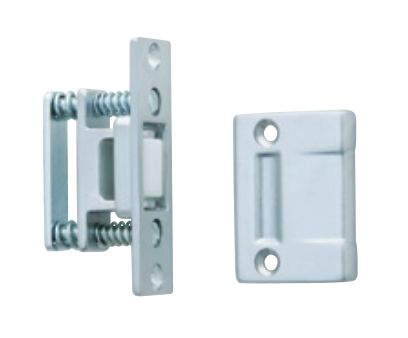 I’ve received quite a few questions about roller latches lately, with regard to the CMS prohibition on using roller latches on corridor doors in hospitals and nursing homes. A roller latch is designed to keep a door in the closed position, but it is not considered a positive latch. Although many corridor doors in health care facilities are not required to be fire-rated, they are required by NFPA 101 – Life Safety Code to be self-latching and have positive-latching hardware.
I’ve received quite a few questions about roller latches lately, with regard to the CMS prohibition on using roller latches on corridor doors in hospitals and nursing homes. A roller latch is designed to keep a door in the closed position, but it is not considered a positive latch. Although many corridor doors in health care facilities are not required to be fire-rated, they are required by NFPA 101 – Life Safety Code to be self-latching and have positive-latching hardware.
NFPA 101 includes a couple of exceptions where corridor doors may be equipped with roller latches (some doors in existing facilities as well as psychiatric units), but CMS (Centers for Medicare and Medicaid Services) does not allow roller latches to be used on corridor doors in hospitals and nursing homes. The exception to this prohibition is for rooms such as toilet rooms, bathrooms, shower rooms, sink closets, and similar auxiliary spaces that don’t contain flammable or combustible materials (see below for more info). If a door is within a suite, a roller latch may be acceptable since those doors don’t typically have a positive-latching requirement. This is not a new requirement; the 2003 CMS directive on roller latches can be found here.
From the CMS Final Rule which adopts the 2012 edition of NFPA 101:
18.3.6.3.9.1 and 19.3.6.3.5–Roller Latches
A roller latch is a type of door latching mechanism to keep a door closed. The 2012 edition of the LSC requires corridor doors to be provided with a means for keeping the door closed that is acceptable to the authority having jurisdiction. The LSC permits roller latches capable of keeping the door fully closed if a force of 5 pounds is applied at the latch edge or roller latches in fully sprinklered buildings. However, we proposed not to adopt these standards from the 2012 LSC. Through fire investigations, roller latches have proven to be an unreliable door latching mechanism requiring extensive maintenance to operate properly. Many roller latches in fire situations failed to provide adequate protection to residents in their rooms during an emergency. Roller latches will be prohibited in existing and new Health Care Occupancies for corridor doors and doors to rooms containing flammable or combustible materials. These doors will be required to have positive latching devices instead.
A clarification about rooms without combustible materials was published in the Federal Register on May 4, 2016:
Comment: Some commenters agree with the continued prohibition of roller latches in facilities, as they are a safety concern. However, some commenters stated that some doors are not required to latch (that is, toilet rooms, bathrooms) and that roller latches should be allowed on those particular doors with no penalty. A few commenters also discussed the importance of roller latches in psychiatric units. Those commenters stated that roller latches have limited uses on psychiatric units to address patients barricading themselves in their rooms or using hanging points (on the levers) for potential suicides.
Response: CMS would like to clarify that roller latches are prohibited on all corridor doors. However, doors to toilet rooms, bathrooms, shower rooms, sink closets, and similar auxiliary spaces that do not contain flammable or combustible materials would be allowed to have roller latches. We do not believe that permitting the use of roller latches in auxiliary spaces presents a danger to patients or staff. Therefore, we have revised the proposed regulatory requirement throughout this rule to clarify this distinction. We note that this requirement is different than the 2012 LSC requirement for door latching.
So here’s my question (finally!)…for corridor doors with existing roller latches, what is the preferred method for replacing the roller latches with hardware that is acceptable to CMS? WWYD?
NFPA has a page on their website dedicated to resources related to health care facilities and the CMS adoption of the NFPA codes. You can access this page by clicking here.
You need to login or register to bookmark/favorite this content.





The Glynn-Johnson HL-6/RL push/pull roller latch conversion kit converts existing G-J roller latches to meet current federal standard requirements.
Thanks Pete!
– Lori
The doors in question are perfect candidates for hospital latches. A hospital latch can be passage, privacy, or locking function as needs dictate. The problem is the latchbolt prep and chassis modifications to existing doors. Since these doors are not fire doors field modifications are permitted, though I grant that few installers are proficient. But this is the best solution because in most cases the frame was prepared for an ASA strike. If not, then the field modification required to the frame makes the field change more difficult yet. Remember, if it was easy, they wouldn’t call it “hard”ware.
They would call it EASY-ware! 🙂
– Lori
A local hospital recently called me in a panic (no pun intended) because they were convinced a roller latch was a Von Duprin 299 strike (due to the little ‘roller’ on it) and they were forbidden by the Code. I tried to convince them otherwise but to no avail so I sold them a bunch of Sargent 649 strikes. Ironically, the real roller latches are still in place.